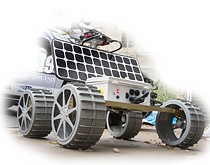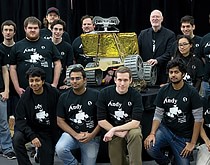John Mann can’t quite place CMU roboticist Red Whittaker’s name when he’s hitting “send” on a cold email request. It’s summer 2014, and the Carnegie Mellon computer science sophomore is asking Whittaker if he can join his team that is dedicated to landing a robot on the moon.
 It's all part of the Google Lunar XPRIZE competition, which has a $30 million grand prize for the first team to land on the moon. To be eligible, the successful journey must happen before 2017, and a robot will need to travel at least 500 meters on the moon’s surface. Many experts consider Astrobotic Technology, spun out of CMU by Whittaker, to be the favorite.
It's all part of the Google Lunar XPRIZE competition, which has a $30 million grand prize for the first team to land on the moon. To be eligible, the successful journey must happen before 2017, and a robot will need to travel at least 500 meters on the moon’s surface. Many experts consider Astrobotic Technology, spun out of CMU by Whittaker, to be the favorite.
When Mann gets Whittaker’s email response, two words stand out: “You’re interesting.”
Mann is brought on board to code the user interface software that will be used to drive the moon-walking robot “Andy,” as manage the massive amount of data that Andy will send back to Earth.
A few months on the job it dawns on Mann how he knew Whittaker. Another summer. Middle school. A LEGO robotics camp. Watching a DARPA Grand Challenge documentary featuring a robotics rock star who entered not just one, but two robots.
 Mann is similarly awestruck by his talented team co-members. No wonder: Earlier this year, the Astrobotic team won $1.75 million in XPRIZE milestone prizes for mobility, imaging, and landing. It was the only team to win in all three categories among the 18 competitors from around the globe.
Mann is similarly awestruck by his talented team co-members. No wonder: Earlier this year, the Astrobotic team won $1.75 million in XPRIZE milestone prizes for mobility, imaging, and landing. It was the only team to win in all three categories among the 18 competitors from around the globe.
“It’s not all about the prizes,” Mann points out, adding that the team plans to drive Andy into the moon’s Lacus Mortis region, exploring for future settlement sites. During the Apollo missions, scientists knew little beyond the moon’s rocky surface, which is hostile to life because of temperature extremes, radiation, and micro-meteorites. Ground-penetrating radar has since revealed underground caves more suitable for a long stay.
“So, ironically,” Mann says, “We’re using all of our science and technology to become cavemen again.”
—Jennifer Bannan (DC’91)



